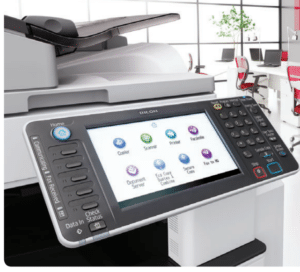What is color coverage, and how can this affect your monthly payments? Most people believe they understand these factors, but even most copier reps don’t know how coverage affects your monthly costs.
What Is Color Coverage, and How Does It Get Calculated?

Color coverage, in its most basic form, is how much a page gets covered in color. That part is easy to understand. What doesn’t make much sense right away is how that coverage gets calculated.
The maximum amount of coverage isn’t 100%; it’s technically 380%.
Why is this possible?
A color copier uses four color toner cartridges, each with a distinct color: black, magenta, cyan, and yellow. Each cartridge can color up to 95% of each page.
If you print a page covered entirely in black ink, that black ink will count as 95% color coverage. However, if you print a completely orange page, you will use roughly 160% color coverage, since you’re using two color cartridges (magenta and yellow) to make that image.
How Does This Color Coverage Affect Your Monthly Costs?
Many copier contracts you see will set a historical average limit of 20% color coverage. However, this color coverage limit doesn’t refer to how much of the page you cover; it relates to how much total toner gets used, even for single colors, as they require a combination of color cartridges to produce.
When you have a 20% color coverage limit, that limit means you have used only 5% of each cartridge to reach a total of 20%.
How Do You Keep Yourself From Paying Overages for Color Coverage?
You can take these four steps to curb your monthly color coverage costs immediately:
- Remove any provision that allows for an upcharge if coverage exceeds 20%. If, for whatever reason, you can’t remove this provision from your contract, make sure you keep your historical color coverage averages below 20%.
- Compile print files your rep can run to test the copier’s color coverage. Have the rep run an analytics tool to give you an accurate coverage number. Don’t let your rep give you a coverage number without using this analytics tool.
- If you have machines with no color coverage restrictions, run your high coverage prints on these machines. Run your lower coverage prints through your less expensive printers.
- Keep in mind that tabloid sheets are twice as large as standard sheets. If you print tabloid sheets, you will use double the toner. Your coverage costs will reflect this difference. To keep your coverage costs from going over with tabloid prints, use only 10% coverage for these larger prints.
Follow these steps, and you can save thousands of dollars over the life of your copier from color coverage savings alone. Make sure you set your copiers up to ensure your workers aren’t using color when they shouldn’t, and you will keep your color coverage, and your monthly copier bill under control.
